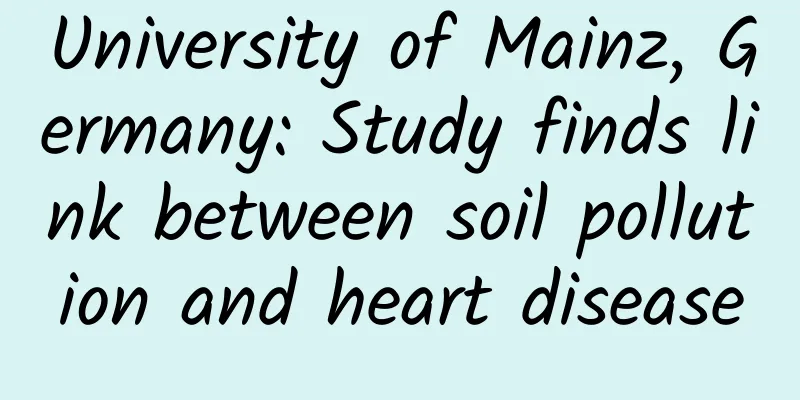University of Mainz, Germany: Study finds link between soil pollution and heart disease

|
Pesticides and heavy metals in soil may have adverse effects on the cardiovascular system, according to a recent review article published in Cardiovascular Research, a journal of the European Society of Cardiology (ESC). "Compared with dirty air, soil pollution is less obvious as a risk to human health," said author Professor Thomas Münzel of the University Medical Center Mainz in Germany. "But there is growing evidence that pollutants in soil may impair cardiovascular health through a number of mechanisms, including inflammation and disruption of the body's natural clock." Studies have shown that pollution in the air, water and soil causes at least 9 million deaths each year. In addition, more than 60% of pollution-related illness and death are due to cardiovascular diseases such as chronic ischemic heart disease, stroke, heart attack and arrhythmia (heart rhythm disorders). The research paper highlights the relationship between soil pollution and human health, particularly cardiovascular disease. Soil pollutants include heavy metals, plastics, and pesticides. According to the authors, contaminated soil may contribute to cardiovascular disease by increasing oxidative stress in blood vessels (having more "bad" free radicals and fewer "good" antioxidants), by causing inflammation, and by disrupting the body's clock (circadian rhythm). Dirty soil can enter the body through inhalation of desert dust, fertilizer crystals, or plastic particles. Heavy metals, such as cadmium and lead, plastics, and organic poisons (such as those in pesticides) can also enter through oral ingestion. In addition, soil pollutants wash into rivers, forming dirty water that may be consumed. Pesticides have been linked to an increased risk of cardiovascular disease. Employees in the agricultural and chemical industries face the greatest exposure, but the general public can also ingest pesticides from contaminated food, soil, and water. Cadmium is a heavy metal that occurs naturally in small amounts in air, water, soil and food, and also comes from industrial and agricultural sources. In non-smokers, food is the main source of cadmium. Population studies have shown mixed results on the relationship between cadmium and cardiovascular disease, according to the document, which cites a Korean study showing that middle-aged Koreans with high blood cadmium levels had an increased risk of stroke and hypertension. Lead is a naturally occurring toxic metal that is contaminated in the environment through mining, smelting, manufacturing and recycling. Studies have found an association between high blood lead levels and cardiovascular disease, including coronary heart disease, heart attack and stroke, in women and people with diabetes. Further research has shown a higher risk of death from cardiovascular disease associated with exposure to arsenic, a naturally occurring metallic compound that can be present in increased levels due to industrial processing and the use of contaminated water to irrigate crops. The paper states that "while soil heavy metal contamination and its association with cardiovascular disease is particularly a problem for low- and middle-income countries because their populations are disproportionately exposed to these environmental contaminants, it becomes a problem in any country in the world due to the increasing globalization of food supply chains and the absorption of these heavy metals by fruits, vegetables, and meat." People are paying attention to the potential hazards of dust in polluted air. Desert dust can travel great distances, and studies have linked soil particles from China and Mongolia to increased rates of heart attacks in Japan. Cardiovascular emergency department visits in Japan increased by 21% on days with high exposure to Asian dust. While there are no population studies on the effects of nano- and microplastics on human cardiovascular health, research suggests that these particles can enter the bloodstream, making it plausible that they could enter organs and cause systemic inflammation and cardiometabolic disease. Professor Münzel said: "More research is needed on the combined effects of multiple soil contaminants on cardiovascular disease, as we are rarely exposed to one toxicant alone. Research into how nano- and microplastics may initiate and exacerbate cardiovascular disease is urgently needed. Until we know more, it seems prudent to wear a mask to limit exposure to windblown dust, filter water to remove contaminants, and buy food grown in healthy soil." From cnBeta.COM |
Recommend
What is the real traffic of major information flow platforms? Just look at the latest data and you’ll know! Channel essential!
When creating information flow , besides optimiza...
How to use fastboot to flash the original image to Android
If your phone has an unlocked bootloader, you can...
Skyworth Auto: In 2022, Skyworth Auto's total sales volume reached 21,916 units, a year-on-year increase of 255.72%.
Skyworth Auto announced its delivery data for Dec...
2500 words user retention analysis
Faced with the current situation of difficulty in...
Yamaha establishes new automotive technology concept brand, will launch the most powerful motor, up to 2000 horsepower
Yamaha, a world-renowned manufacturer with great ...
An ancestral precept has governed the country for 600 years. This "pearl" in the vast forest of northern Fujian is creating an ecological miracle.
Wanmulin Nature Reserve in Jianou City, Fujian Pr...
How did it become "non-mainstream" when it was known as the "ancient plastic"?
Exquisite and beautiful porcelain represents the ...
New evidence shows that the "iPhone 12 notch" is indeed narrower
Twitter whistleblower Jon Prosser shared new imag...
These "foreign specialties" have become domestic products
Recently, Yunnan Plus avocados were put on the sh...
Advice from frontline personnel: How to avoid cross infection during nucleic acid testing?
Recently, epidemics have occurred frequently in v...
Sharp under Foxconn’s thinking: the father of LCD or the king of low prices?
Since Foxconn took over Sharp in August last year...
Why is the Note 7 explosion treated differently in the Chinese market? Samsung still has no explanation
Today, Samsung officially held a Note 7 briefing,...
HDR TV sales will reach 2.5 million units next year, but the industry chain development faces huge challenges
At the opening ceremony of this year's Rio Ol...
Take you into the secrets behind the red envelopes in Moments photos!
The WeChat Moments photo red envelopes were in fu...
I was bitten by a snake! What should I do? What should I do?
Life is not just about the immediate, but also ab...









